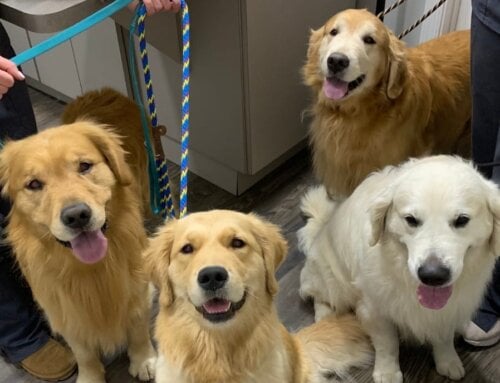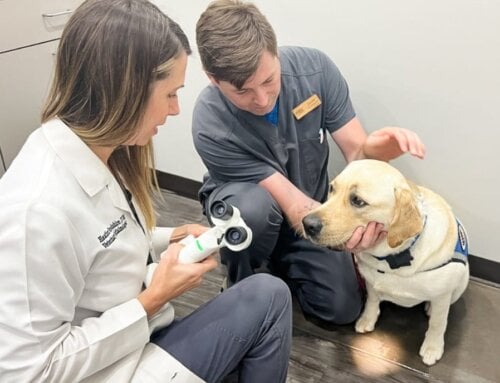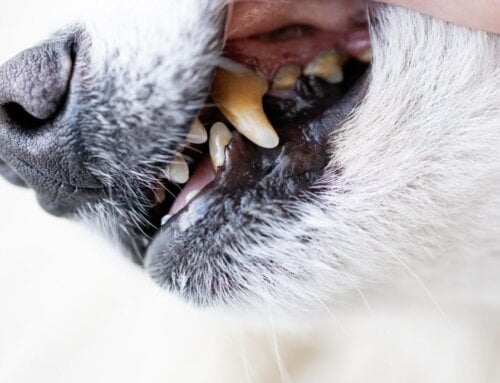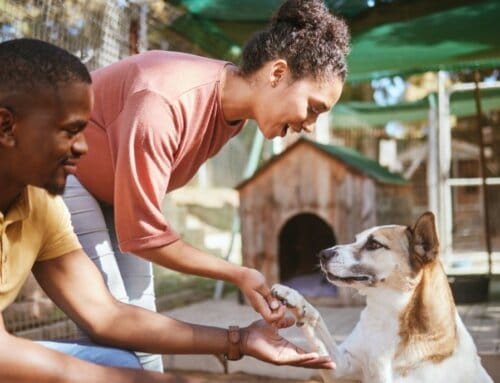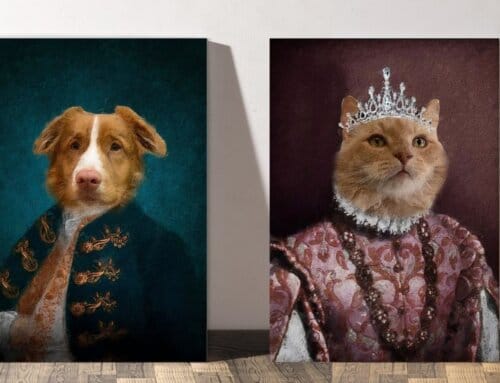A Q&A with Brianne Radulovich, DVM, Comparative Ophthalmology Resident
Eyecare for horses? Just like us, horses are prone to ocular issues. With their horizontally, elongated pupils, a horse’s eye is eight times larger than the human eye. They use it for light capture and motion detection. With a total vision field of nearly 360 degrees, horses can see their tail when their head is forward! This was important for horses years ago so they could keep an eye on their surroundings—and predators—when grazing and working. Good eye health plays a key role in their living a safe and productive life.
In addition to the dogs, cats and other animals we see at Animal Vision Center of Virginia, we treat horses too. In this Q&A, Dr. Brianne Radulovich, DVM, our comparative ophthalmology resident, looks at the common equine eye conditions and how we treat them.
How can you tell if a horse may have vision issues?
We perform specific tests during our eye exams to determine if a horse is visual. Animals can adapt well to being non-visual, especially when it affects only one eye. This makes it difficult to discern if an animal has vision issues. A horse may have vision problems if it is …
- Seeming startled by objects or frequently acting “spooky”
- Not reacting or acknowledging your presence or the presence of an object
- Bumping into or having difficulty locating objects, such as feed buckets and pasture gates
- Having difficulty performing tasks or gauging depth perception (reluctant to jump fences, go around objects, walk through gates, etc.) when these tasks had been routine in the past
- Having difficulty seeing at night or in shaded areas; similarly, the horse may seem more reluctant
- Appearing to have abnormal pupils, such as pupils that are more dilated than usual or pupils that do not constrict in bright lights
- Exhibiting pupils that are asymmetric between eyes
What takes place during an equine eye exam?
First, we observe the horse from a distance to look for any asymmetry or abnormalities of the eyes. Then, we perform vision and nerve tests to evaluate the function of the eyes and eyelids. Horses have strong muscles within their eyelids that allow them to blink. Occasionally to facilitate the exam, we use local injectable analgesia, such as lidocaine. This temporally blocks these nerves to prevent horses from holding their eyes shut.
We then use a handheld magnification device that contains a bright beam of light to visualize details of the front of the eye. With this, we can assess the cornea (the clear front portion of the eye), iris, and lens, among other structures. Next, we use a handheld magnification lens to evaluate the back of the eye. This process allows us to see the retina and optic nerve. We frequently perform initial diagnostics, such as eye pressure and fluorescein staining (to check for ulcers). If needed, we may recommend additional diagnostic tests, such as cytology, swab cultures and bloodwork, to name a few. Depending on the horse, we may or may not use local analgesia to block the eyelids or injectable sedation. And we often perform our eye exams in a stall with a halter and lead rope.
Do the conditions in which they live (outdoors/in a stall) impact the condition of their eyes?
Horses have laterally positioned eyes that come into close contact with halters, bridles, and blankets. Their environment consists of vegetative material including hay, shavings and grass. These combined conditions predispose horses to ocular trauma and corneal ulcerations. Corneal ulcers can easily become infected with bacteria and/or fungus. We must identify and treat such conditions to reduce the risk of uncontrolled infection or secondary complications. For horses housed outdoors, ultraviolet light from the sun increases their risk of developing certain types of cancers. This includes squamous cell carcinoma, which can affect the cornea and eyelids in horses. We more commonly see squamous cell carcinoma in light-pigmented horses, as well as in certain breeds of horses, such as Appaloosas, Paints, Haflingers, and Belgians.
What are the more common ocular conditions that can occur in horses and how do you treat them?
- Trauma, such as eyelid lacerations. A timely assessment is important to reduce the risk of infection; repair the normal function of the ocular structures; and improve cosmetic appearance. We manage the repair with skin sutures.
- Corneal ulcers and abscesses are frequent equine problems. We treat these with aggressive topical medical therapy, antibiotics and/or anti-fungal medications. If medicating with eyedrops is difficult, we may place a tubing system (sub-palpebral lavage system) beneath the horse’s eyelid and braid it into the mane to facilitate easier treatment. In severe cases, we may recommend surgery to strengthen the cornea, reduce the risk of complications and promote healing.
- Equine recurrent uveitis (ERU), also known as “moon blindness,” is the most common cause of blindness in horses. ERU presents as inflammation within the eye that reoccurs weeks to months after the initial episode. We suspect that the origin of the disease is immune-mediated; however, systemic infectious diseases, such as leptospirosis, have also been associated with ERU. Acute signs include sensitivity to light, squinting, cloudiness to the surface of the eye and the appearance of a small pupil. In later stages, horses can develop cataracts, secondary glaucoma (elevated eye pressures), shrinking of the eye and blindness. ERU susceptibility may be heritable. In the U.S., we see it more commonly in Appaloosas. Treatment aims at decreasing pain and inflammation, as well as preserving vision. Medications include topical and oral anti-inflammatories. However, we can use immunomodulatory medications as implants for long-term management.
- Immune-mediated ocular diseases can also occur in horses, two of which include immune-mediated keratitis (IMMK) and eosinophilic keratitis. In these conditions, inflammation occurs in the cornea and can cause vessel growth and scarring. In eosinophilic keratitis, inflammatory plaques can also develop and appear as white raised lesions on the eye’s surface. Immune-mediated diseases require long-term therapy for control with immunomodulatory medications.
- Glaucoma is a disease in which the pressure within the eye is elevated. Primary glaucoma is heritable, often bilateral and can present as diffuse cloudiness to the surface of the eye. Left untreated, glaucoma can lead to irreversible damage and blindness. Treatment aims at decreasing any underlying inflammation within the eye and reducing ocular pressure. When medical therapy is no longer successful at managing disease, there are surgical options, such as laser cyclophotocoagulation, that can reduce fluid production in the eye and thus eye pressure.
How does one manage their horse if they become blind?
Limiting some riding activities may help with the safety of the rider and horse. However, non-visual horses can still have a normal quality of life and live comfortably. Animals have an incredible ability to adjust to their environment. They use their other senses, including hearing and smell, to explore new areas. We recommend removing hazardous objects from their stalls and pastures, if possible, to reduce the risk of injury. It may also be helpful to pasture your non-visual horse with a support animal, such as another horse or farm animal.
What preventive measures do you suggest for keeping a horse’s eyes healthy?
Looking at and monitoring your horse’s eyes daily is one of the most important preventative measures you can take. If you notice any squinting, cloudiness, redness, discharge, swelling, vision changes, pain or discomfort, contact us or your primary care veterinarian for next-step recommendations. If any questions or concerns arise, please do not hesitate to contact us at Animal Vision Center of Virginia. Our team is more than happy to help. We love our horses!
Learn more about the conditions we treat and the ophthalmic services we offer at Animal Vision Center of Virginia.


















